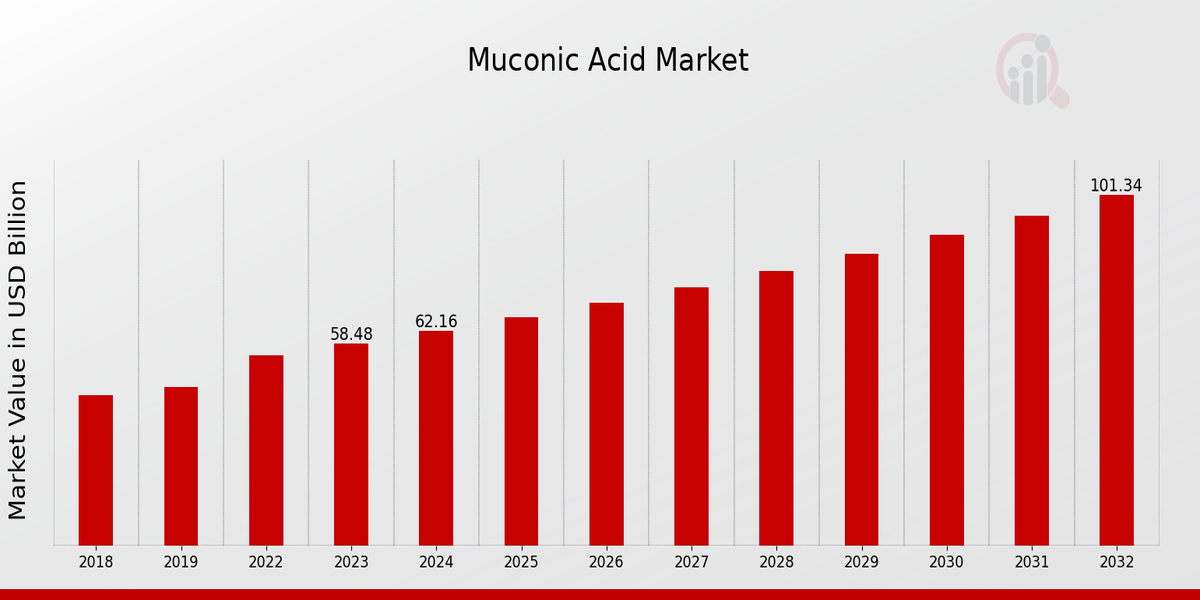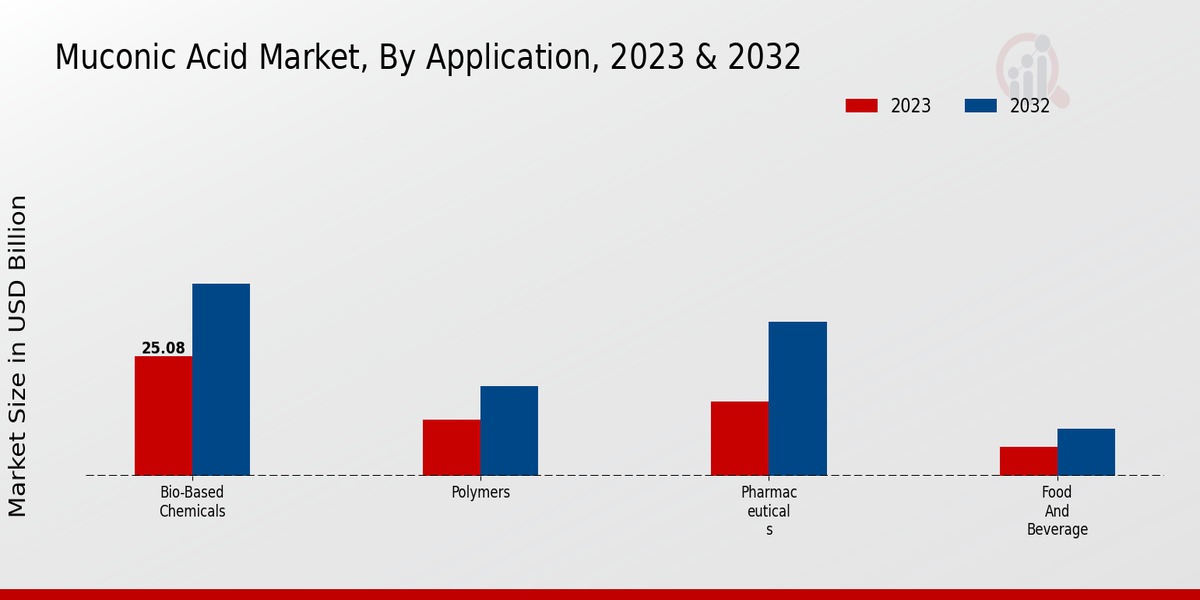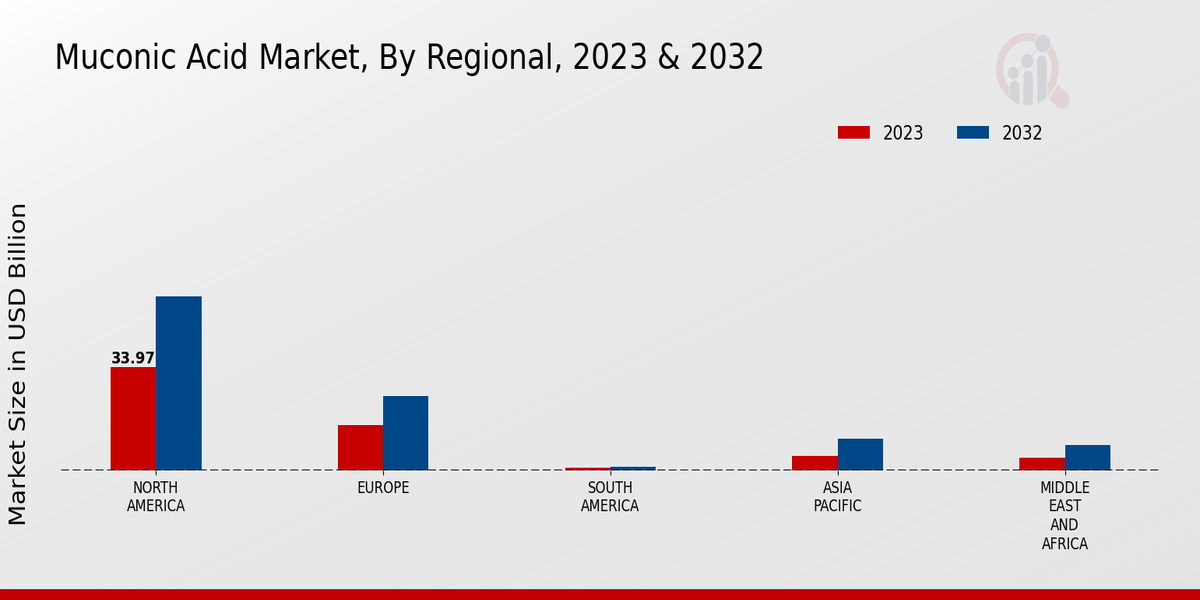Global Muconic Acid Market Overview
The Muconic Acid Market Size was estimated at 66.11 (USD Billion) in 2024. The Muconic Acid Industry is expected to grow from 70.29(USD Billion) in 2025 to 122.03(USD Billion) by 2034. The Muconic Acid Market CAGR (growth rate) is expected to be around 6.30% during the forecast period (2025 - 2034).
Key Muconic Acid Market Trends Highlighted
The Muconic Acid Market is at a change which has been attributed to the rise in demand for biobased and biodegradable materials. It is obtained from renewable sources, and therefore, it is expected to target the substitution of fossil fuel chemicals. One of the most important tendencies on the market is the increasing use of muconic acid in bio-plastic production processes. This is because muconic acid is used in the synthesis of polyhydroxyalkanoates (PHAs), which are biodegradable and compostable plastics. Besides, muconic acid is also being investigated for bio solvents, bio-detergents and cosmetics.
The main market drivers are increasing capacity for sustainable sourcing of materials, increasing awareness about petrochemical-based products, and advanced technologies developed for the production of muconic acid. Growth prospects in the market are driven largely by exploring new areas of application for muconic acid, increasing the production volume, and building sound alliances among key industry players.

Source: Primary Research, Secondary Research, MRFR Database and Analyst Review
Muconic Acid Market Drivers
-
Rising Demand for Bio-Based Chemicals
Muconic acid is a bio-based chemical established from renewable resources that include biomass and other plant-based materials. Increasing demand for bio-based chemicals is a major factor fueling the muconic acid market on a scale. Bio-based chemicals have significant applications in the production of plastic, pharmaceuticals, and food additives. Muconic acid can also serve as a key component of other types of bio-based products. Accordingly, as the requirement for bio-based chemicals continues to increase, the muconic acid market is expected to escalate.
Increasing Adoption of Biodegradable Plastics
Muconic acid is an important input in the manufacture of biodegradable plastic material with the general advantage that it can be decomposed by microorganisms to form natural products, such as carbon dioxides and water. The increasing realization of the values of biodegradable plastics is one of the major influential factors in the muconic acid market. Their applications vary from products for consumers to agricultural products to packaging.The increasing development and production of biodegradable plastic material implies that the use of muconic acid is anticipated to rise.
Government Regulations and Initiatives
Government regulations and initiatives that are focused on reducing the negative impact of plastics on the environment are also driving the growing adoption of muconic acid on a level. Many governments worldwide have already introduced some sort of regulation that limits the use of some types of plastic, such as single-use plastics. As a result, there is now a demand for more sustainable alternative products, such as bio-based plastics. In addition, the governments are providing financial incentives to companies that make an effort to develop and use bio-based materials.This is likely to make producing muconic acid and other bio-based chemicals in the future far more beneficial for several companies.
Muconic Acid Market Segment Insights
Muconic Acid Market Application Insights
The application segment plays a crucial role in shaping the Muconic Acid Market. Various end-use industries utilize muconic acid for a diverse range of applications. Bio-based chemicals: Muconic acid serves as a sustainable feedstock for the production of bio-based chemicals. Its unique chemical structure enables the synthesis of biodegradable and renewable alternatives to traditional petroleum-based chemicals. The growing demand for sustainable solutions is driving the adoption of bio-based chemicals, creating significant opportunities for muconic acid in this segment.Polymers: Muconic acid finds application in the production of various polymers, including polyesters and polyamides. These polymers possess desirable properties such as biodegradability, high strength, and chemical resistance, making them suitable for use in packaging, automotive, and construction industries. The increasing demand for eco-friendly and high-performance polymers is expected to boost the growth of muconic acid in this segment. Pharmaceuticals: Muconic acid exhibits potential applications in the pharmaceutical industry as an intermediate for the synthesis of active pharmaceutical ingredients (APIs).It can be used to produce antibiotics, anti-inflammatory drugs, and other therapeutic agents. The growing pharmaceutical industry and the need for innovative drug development are anticipated to drive the demand for muconic acid in this segment. Food and beverage: Muconic acid has applications in the food and beverage industry as a flavoring agent and preservative. It can enhance the taste and extend the shelf life of various food and beverage products. The increasing demand for natural and clean-label ingredients is expected to support the growth of muconic acid in this segment.Other applications: In addition to the major segments mentioned above, muconic acid finds applications in various other industries, including cosmetics, personal care, and agriculture. Its unique properties make it suitable for use as a raw material in the production of fragrances, cosmetics, and crop protection chemicals. The growing demand for natural and sustainable ingredients is expected to drive the growth of muconic acid in these segments. The Muconic Acid Market is expected to witness significant growth in the coming years, driven by the increasing demand for bio-based chemicals, polymers, pharmaceuticals, and other applications.The market is expected to witness technological advancements and innovations, leading to the development of new applications and products based on muconic acid.

Source: Primary Research, Secondary Research, MRFR Database and Analyst Review
Muconic Acid Market Production Process Insights
The Muconic Acid Market is segmented by Production Process into Benzene-based process, Glucose-based process, and Other production processes. The benzene-based process segment dominates the market in terms of revenue. The glucose-based process segment is expected to be the fastest-growing market during the forecast period. The benzene-based process is a traditional method for the production of muconic acid. The process includes the oxidization of benzene to produce maleic anhydride, which is then converted to muconic acid. The benzene-based process is less expensive to produce and is a more established process investment.As a result, the segment dominates the market. The glucose-based process is a greener alternative to the benzene-based process. The process includes the fermentation of glucose to produce muconic acid. The glucose-based process may not only produce muconic acid that is more environmentally friendly but also may produce muconic acid at a lower cost than the benzene-based process. As a result, the segment is expected to grow at a higher rate., as well. The other production processes segment may include catalytic oxidation of furfural and the bioconversion of biomass.These processes are also expected to produce muconic acid at a lower cost and may serve to be greener alternatives to produce muconic acid. However, the reasons are still in the nascent stages of development.
Muconic Acid Market Feedstock Source Insights
The muconic acid market is segmented based on feedstock source into fossil-based feedstock, bio-based feedstock, and renewable feedstock. Among these segments, the fossil-based feedstock segment held the largest market share in 2023, and it is expected to continue dominating the market during the forecast period. The growth of this segment can be attributed to the low cost and easy availability of fossil-based feedstocks, such as benzene and maleic anhydride. However, the bio-based feedstock segment is expected to witness significant growth during the forecast period.This growth can be attributed to the increasing demand for sustainable and renewable products. Bio-based feedstocks, such as glucose and biomass, are derived from plant-based materials, which are renewable and sustainable. The renewable feedstock segment is also expected to witness growth during the forecast period due to the increasing adoption of renewable energy sources.
Muconic Acid Market End-Use Industry Insights
The Muconic Acid Market is segmented into various end-use industries, including automotive, packaging, construction, electronics, and other end-use industries. The automotive industry is a major consumer of Muconic Acid, accounting for a significant share of the market revenue in 2023. The demand for Muconic Acid in the automotive industry is driven by its use in the production of lightweight and fuel-efficient vehicles. Muconic Acid is also gaining traction in the packaging industry, particularly in the production of sustainable and eco-friendly packaging solutions.The construction industry presents another significant opportunity for Muconic Acid, with its increasing use in the production of durable and fire-resistant materials. Furthermore, the electronics industry is exploring the use of Muconic Acid in the development of advanced electronic components. Other end-use industries, such as pharmaceuticals and cosmetics, are also contributing to the growing demand for Muconic Acid, fostering market growth in the coming years.
Muconic Acid Market Grade Insights
The Muconic Acid Market is segmented by grade into industrial grade, pharmaceutical grade, and food grade. Among these, the industrial grade segment held the largest market share in 2023, accounting for over 70% of the market revenue. This is due to the high demand for muconic acid in the production of adipic acid, which is used in the manufacturing of nylon and other synthetic fibers. The pharmaceutical grade segment is expected to grow at the highest CAGR during the forecast period, owing to the increasing demand for muconic acid in the production of antibiotics and other pharmaceutical products.The food-grade segment is also expected to witness significant growth, driven by the rising demand for muconic acid as a food additive and preservative.
Muconic Acid Market Regional Insights
The Muconic Acid Market is segmented into North America, Europe, APAC, South America, and MEA. North America is the largest regional market for muconic acid, accounting for over 35% of the market in 2023. The region's strong demand for bio-based chemicals and its well-established chemical industry are key drivers of growth. Europe is the second-largest regional market, with a share of over 25%. The region's stringent environmental regulations and its focus on sustainability are contributing to the growth of the muconic acid market.APAC is the fastest-growing regional market, with a CAGR of over 7%. The region's rapidly developing economy and its increasing demand for sustainable chemicals are driving growth. South America and MEA are relatively small markets for muconic acid, but they are expected to grow in the coming years as the demand for bio-based chemicals increases.

Source: Primary Research, Secondary Research, MRFR Database and Analyst Review
Muconic Acid Market Key Players And Competitive Insights
Major players in the Muconic Acid Market industry are constantly striving to gain a competitive edge by investing in research and development, expanding their product portfolio, and forming strategic partnerships. Leading Muconic Acid Market players are focusing on developing innovative and sustainable technologies to meet the evolving needs of end-users. The Muconic Acid Market is highly competitive, with several established and emerging players vying for market share. Key players are adopting various strategies, such as mergers and acquisitions, joint ventures, and collaborations, to strengthen their position in the market. The competitive landscape is expected to further intensify in the coming years as new entrants join the market and existing players expand their reach.DSM, one of the leading players in the Muconic Acid Market, is committed to sustainability and innovation. The company has developed a bio-based process for the production of muconic acid, which reduces the environmental impact compared to traditional production methods. DSM also offers a range of Muconic Acid Market products and solutions for various applications, catering to the needs of diverse customers. The company's strong focus on research and development, coupled with its commitment to sustainability, positions it as a key player in the Muconic Acid Market.BASF, another prominent player in the Muconic Acid Market, is known for its extensive product portfolio and presence. The company offers a wide range of Muconic Acid Market products, including bio-based and chemically synthesized options. BASF has a strong focus on innovation and is continuously investing in the development of new technologies and applications for muconic acid. The company's reach and diverse product portfolio make it a formidable competitor in the Muconic Acid Market.
Key Companies in the Muconic Acid Market Include
- Metabolic Explorer
- BASF
- Genomatica
- CJ Bio
- Novomer
- Bioon
- BioAmber
- DSM
- Toray Industries
- Myriant
- INVISTA
- Mitsubishi Chemical
- Qore
- Ube Industries
- Sulzer Chemtech
Muconic Acid Market Industry Developments
Muconic acid is a versatile platform chemical used in various industries, including automotive, construction, and packaging.Recent developments in the muconic acid market include the increasing adoption of bio-based feedstocks, such as corn stover and sugarcane bagasse. This shift towards sustainable feedstocks is driven by environmental concerns and government regulations promoting the use of renewable resources. Additionally, advancements in fermentation and purification technologies are optimizing production processes, reducing costs, and improving product quality.Key players in the muconic acid market are investing in research and development to expand their product portfolios and establish strategic partnerships. Mergers and acquisitions are also expected to shape the market landscape as companies seek to consolidate their positions and gain a competitive edge.
Muconic Acid Market Segmentation Insights
Muconic Acid Market Application Outlook
- Bio-based chemicals
- Polymers
- Pharmaceuticals
- Food and beverage
- Other applications
Muconic Acid Market Production Process Outlook
- Benzene-based process
- Glucose-based process
- Other production processes
Muconic Acid Market Feedstock Source Outlook
- Fossil-based feedstock
- Bio-based feedstock
- Renewable feedstock
Muconic Acid Market End-Use Industry Outlook
- Automotive
- Packaging
- Construction
- Electronics
- Other end-use industries
Muconic Acid Market Grade Outlook
- Industrial grade
- Pharmaceutical grade
- Food grade
Muconic Acid Market Regional Outlook
- North America
- Europe
- South America
- Asia Pacific
- Middle East and Africa
| Report Attribute/Metric |
Details |
| Market Size 2024 |
66.11(USD Billion) |
| Market Size 2025 |
70.29(USD Billion) |
| Market Size 2034 |
122.03(USD Billion) |
| Compound Annual Growth Rate (CAGR) |
6.30% (2025 - 2034) |
| Report Coverage |
Revenue Forecast, Competitive Landscape, Growth Factors, and Trends |
| Base Year |
2024 |
| Market Forecast Period |
2025 - 2034 |
| Historical Data |
2020 - 2024 |
| Market Forecast Units |
USD Billion |
| Key Companies Profiled |
Metabolic Explorer, BASF, Genomatica, CJ Bio, Novomer, Bioon, BioAmber, DSM, Toray Industries, Myriant, INVISTA, Mitsubishi Chemical, Qore, Ube Industries, Sulzer Chemtech |
| Segments Covered |
Application, Production Process, Feedstock Source, End-Use Industry, Grade, Regional |
| Key Market Opportunities |
Renewable Feedstocks Bioplastics Production Sustainable Coatings Food and Beverage Applications Pharmaceutical Intermediates |
| Key Market Dynamics |
Rising demand for biobased plastics Growing consumption in the packaging industry Technological advancements Government regulations and Sustainability concerns |
| Countries Covered |
North America, Europe, APAC, South America, MEA |
Frequently Asked Questions (FAQ) :
The Muconic Acid market is expected to reach a valuation of approximately USD 70.29 billion in 2025.
The Muconic Acid market is projected to grow at a CAGR of 6.30% from 2025 to 2034.
North American region is expected to hold the largest share of the Muconic Acid market in 2023, driven by increasing demand from end-use industries such as food and beverage, pharmaceuticals, and personal care.
Muconic Acid finds applications in various industries, including food and beverage, pharmaceuticals, personal care, and industrial chemicals. In the food and beverage industry, it is used as a flavoring agent and preservative. In pharmaceuticals, it is used as an intermediate in the synthesis of antibiotics and other drugs. In personal care, it is used as an ingredient in skincare and hair care products. In industrial chemicals, it is used for the production of plastics and other chemicals.
Some of the key competitors in the Muconic Acid market include BASF, DSM, Myriant, and Mitsubishi Chemical Corporation.

















